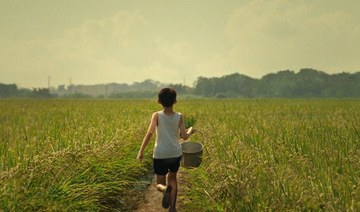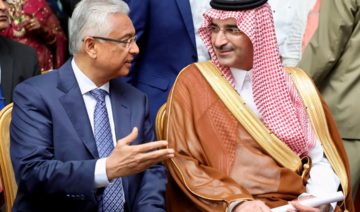RAWALPINDI: Syed Ashraf recalled sitting in tears by the charred wreckage of his music studio after a band of Taliban fighters vandalized the facility days after the hard-line group swept to power in Kabul following the withdrawal of US-led forces in August 2021.
Afghanistan has a strong musical tradition, and a pop music scene had flourished there over the past two decades. But many musicians, fearing for their futures under the Taliban which governs according to a harsh interpretation of Islamic law, fled the country to neighboring Pakistan as Taliban fighters started harassing artists and attacking music venues.
Last week, at a small music school he has opened in Rawalpindi for Afghan refugee students as well as Pakistanis, Ashraf remembered looking at the smoldering remains of the musical instruments at his school on that August day two years ago and deciding he would leave his homeland for Pakistan to build a new life with music and hope.
Today, however, Ashraf, like other exiled Afghan artists, is facing uncertainty again amid Islamabad’s deportation drive against illegal migrants that has disproportionately hit Afghans, who form the largest number of migrants to Pakistan.
While Ashraf and his family members have visas and the government says it will not deport those with valid documents, he still fears Pakistani authorities might ask him to leave in the next phase of the expulsion program.
“Afghan artists who returned to Afghanistan from Iran faced a lot of trouble from the Taliban,” he told Arab News. “They were beaten, thrown into jails … Therefore, we appeal to Pakistan not to send Afghan artists back.”
The last time the Taliban had ruled the country, in the late 1990s, they outright banned music. Soon after taking over again, instruments at the famed Afghanistan National Institute of Music, founded in 2010 as a rare coeducational institute, were destroyed and its administrators and students relocated to Lisbon, Portugal. Renowned for its inclusiveness as a symbol of a new Afghanistan — with boys and girls studying together and performing to full houses in the United States and Europe — the school’s campus was occupied by a Taliban faction and its bank accounts were frozen and its offices ransacked.
Smaller music studios like Ashraf’s never stood a chance.
“I was an engineer by profession, but I learned music out of passion,” Ashraf said. “After teaching myself music, I taught it to children in Afghanistan. However, everything came to an end after the arrival of the Taliban.”
The 62-year-old musician who now lives in Rawalpindi with his family came armed with the firm belief that the best “revenge” against the Taliban would be to ignite the love of music among refugees in Pakistan. He partnered up with 42-year-old Afghan painter, Sayed Ibrahim, whose art gallery in Kabul was also destroyed by the Taliban.
“With the assistance of Sayed [Ibrahim], I established a music academy here [in Rawalpindi] and bought some instruments so I could cultivate a love for music among the youth,” Ashraf said.
“My goal was to teach them, enabling them to express their inner pain and show their love for their homeland by playing music.”
Initially, Ashraf and Ibrahim were not optimistic about the success of their venture but the response was “overwhelming.”
“It has been two to three months since we launched the music academy, and there are 10 to 12 students already enrolled,” Ibrahim told Arab News.
“Music is a necessity for everyone and in my experience, every Afghan, even common people, love music,” an Afghan student at the academy who identified himself only by his first name Fareed said.
“People sing everywhere, in every village, and it’s common to hear music while people are working. It was a very good thing there but unfortunately, it’s now banned.”
Like most other Afghan nationals in Pakistan, he too was worried about his future as well as the future of the teachers and students at the academy, many of whom are refugees.
“COMBAT SADNESS THROUGH MUSIC”
According to the United Nations Refugee Agency (UNHCR), out of 3.7 million Afghans in Pakistan, only 1.4 million are registered. As per a joint report issued by the UNHCR and the International Organization for Migration (IOM), over 450,000 Afghan nationals had returned to their homeland until Dec. 9. Afghan community leaders say even those with Afghan Citizenship Cards and Proof of Proof of Registration documents, both of which entitle staying in Pakistan legally, have been deported.
The wave of expulsions has worried Ahmed Baraham, a 19-year-old student at Ashraf’s music academy, whose family left Afghanistan and entered Pakistan on visas in 2022 after the Taliban banned girls’ education.
He said that he joined the academy after he slipped into a state of depression.
“I want to combat sadness through music as it draws people toward humanity,” Baraham told Arab News. “It’s a soft thing. A person feels a sense of peace by immersing himself in music.”
But there are new fears as Pakistani law enforcement agencies carry out search operations and raids in a bid to round up illegal migrants. Baraham said he too was questioned by the police some weeks ago but allowed to go free after a brief interrogation.
The experience left him in distress for days.
“People have gone into depression due to police raids,” Baraham said. “No one knows what will happen. There were rumors that even those with visas and passports will be deported. We, too, find ourselves in great distress.”
In an op-ed published in The Telegraph on Sunday, Pakistani Prime Minister Anwaar-ul-Haq Kakar said the country would not deport at-risk groups such as musicians, journalists, and human rights activists.
But the young music student was not convinced and feared his fate in Afghanistan under Taliban rule.
“If we can study there and pursue our passion for music, there is no issue for us to go back to Afghanistan,” Baraham said. “But, they [Taliban] consider these things to be forbidden.”
Exiled Afghan musicians fear expulsion from Pakistan, future in Taliban-led homeland
https://arab.news/8jbcd
Exiled Afghan musicians fear expulsion from Pakistan, future in Taliban-led homeland
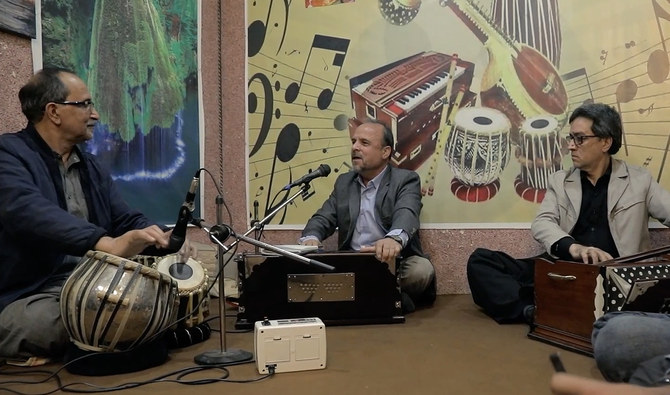
- Afghan artists and musicians fled after the Taliban returned to power in Kabul in 2021
- As Pakistan expels illegal migrants, musicians fear they may be next in line to be deported
Film Review: ‘Mother’s Instinct,’ a psychological thriller that keeps you guessing until the end

- Anne Hathaway plays "the perfect mother" in this 2024 psychological thriller in a remake of a French film, which itself was a novel adaptation
Anne Hathaway has played many roles over the course of her career: a surprise princess, an assistant to a fashion magazine editor, a recovering addict, Cat Woman. In “Mother’s Instinct,” she plays a mother — the perfect mother.
In this 2024 psychological thriller — a remake of a French film which itself was a novel adaptation — Hathaway is joined by Jessica Chastain. The two play best friends who are living the American dream.
They are next-door neighbors. Their husbands are the best of friends, as are their eight-year-old sons. They live in an affluent neighborhood in cookie-cutter 1960s’ suburban America. Everything seems idyllic.
The film begins with Celine’s (Hathaway) birthday. Alice (Chastain) and the women’s husbands throw a surprise backyard party. Celine receives a pearl necklace, a joint gift from their family and friends. It’s a wonderful celebration.
But the next day, there’s a tragic death.

One of the young boys falls from a balcony under suspicious circumstances. At the time, he was being supervised by the other mother.
The film forces us to ask: How can a mother live with herself after she entrusted her son’s life to her friend? Could anyone forgive themselves? Could they forgive their friend?
By mid-film, there are still two mothers — but now one is childless. The one whose son has survived feels guilt. The one who lost her boy feels fury. Both feel grief.
As the story unfolds there are more deaths and we begin to wonder: Did one mother deliberately harm the other’s son? Who is innocent here? Who is evil? Was it an accident or a deliberate act? And who will die next?
Events become more sinister. Nothing seems perfect anymore. Even the beautiful pearl necklace ends up broken on the floor, the tiny gems rolling around chaotically.
First-time director Benoit Delhomme does a good job of leading our eyes where he wants them to go. The cinematography is beautiful, while the styling and outfits are divine.
This film keeps you guessing until the end. And there is no happy ending; sometimes, the happy ending is that there is one at all.
US animation lights up Saudi Film Festival

DHAHRAN: Saudi filmmakers of the future were given a masterclass in the latest animation techniques as part of the Saudi Film Festival this week.
The animation workshops were led by experts from the US as part of a collaboration between the festival and the American Chamber of Commerce and US Consulate in Dhahran.
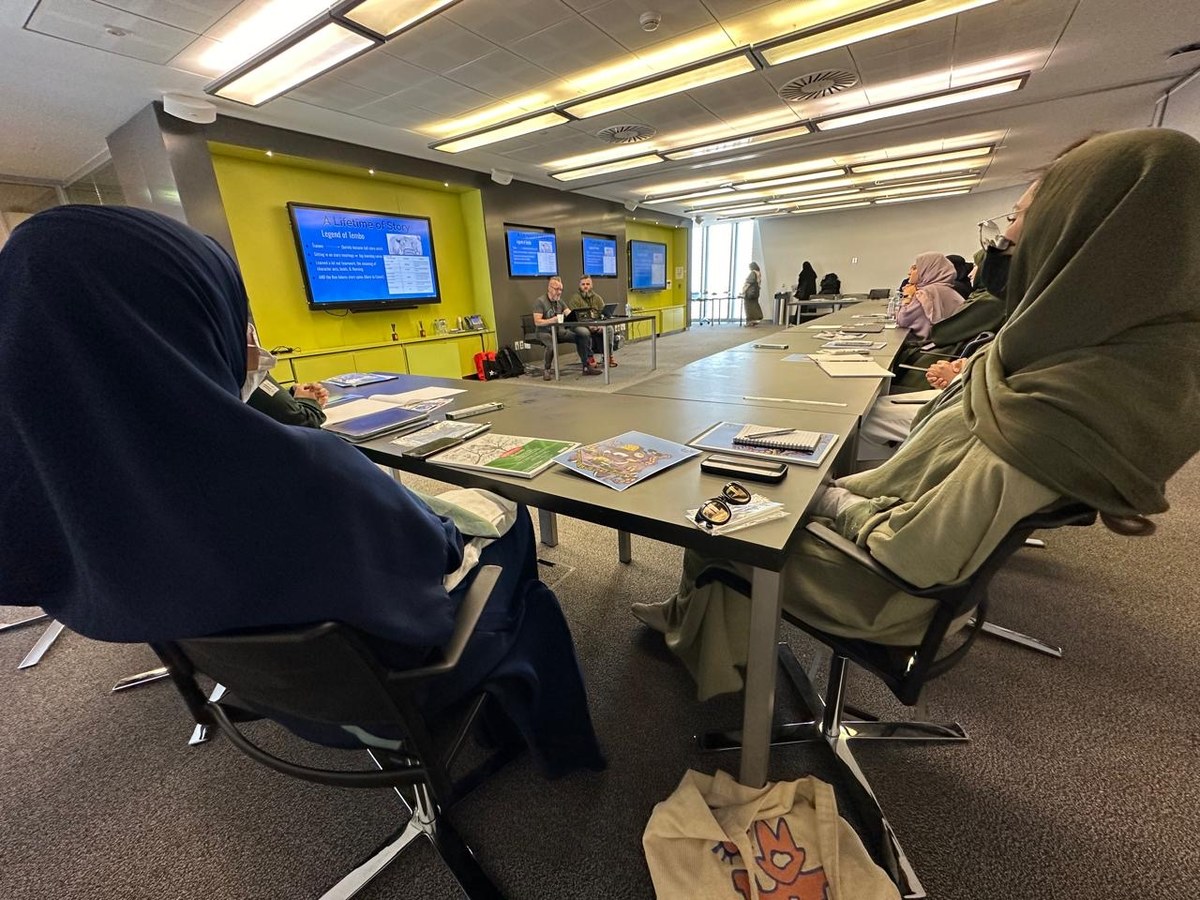
Todd Albert Nims, one of the pioneers in shaping the Saudi film industry over the past decade, told Arab News that with a population of 36 million, many under 35, Saudi Arabia is ripe with potential in the film sector.
Nims, an American who was born and raised in Dhahran, is now head of the AmCham Arts, Culture and Entertainment Committee, and has been involved in all aspects of Saudi-centered films, from acting to producing.
“I went to the first Saudi Film Festival in 2008 and worked with them on bringing the Saudi Film Festival into Ithra … I was there with them, and I’ve been here within this journey for the last 16 years,” he said.
Nims said that many Saudis grew up watching Disney films, and began their filmmaking efforts creating short content on YouTube.
He said there is huge potential for the Saudi market to grow, adding that he wanted to offer young filmmakers the opportunity to “gain expertise right in their backyard.”
Travis Blaise, who has over three decades of experience in animation, and has worked on Disney classics such as “Beauty and the Beast” and “The Lion King,” was on hand to conduct a five-day workshop.
“I was brought on to bring something new and unique to this Saudi Film Festival, which was bringing storytelling, or visual storytelling, to script,” he told Arab News.
Together with fellow American William Winkler, Blaise dedicated each day to bringing the overall picture to life, sketching ideas, developing the story structure, and even discuss the backstory of characters.
The goal was for each student to develop their own 30-second script. The workshop began with 11 students, but the figure soon ballooned to 20.
“Every single student was Saudi; most of them were women from several universities, while a couple were already professionals working in the industry,” Blaise said.
“I love the excitement and passion that they (the Saudi students) share because I have shared that same passion for the last 34 years, and the fact that I can bring something of my own experience to someone who is passionate and open-minded and willing to learn about film really is exciting,” he said.
The experts told Arab News that they are committed to building connections between the US and Saudi film industries, recognizing its potential to inspire, educate, and entertain audiences both domestically and internationally.
“Through filmmaking, we aim to strengthen ties between the US and Saudi Arabia by fostering mutual understanding and creative collaboration,” Alison Dilworth, the US deputy chief of mission, told Arab News.
British Council, Saudi Cinema Association working to ‘drive’ industry growth
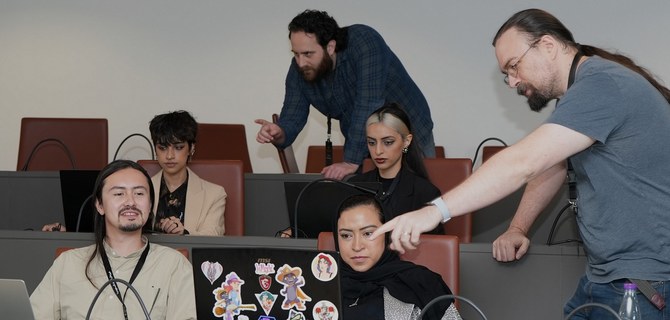
- Two organizations collaborated for 10th Saudi Film Festival
- Aim to find emerging talent and foster cultural exchange
DHAHRAN: The partnership between the British Council and the Saudi Cinema Association this week for the 10th edition of the Saudi Film Festival will help boost the industry, showcase emerging talent, and foster cultural exchange, say officials and creatives.
The event at the King Abdulaziz Center for World Culture, or Ithra, in Dhahran, began on May 2 and concludes on Thursday.
For the occasion, Studio Ulster and the SCA offered a training program to empower Saudi Arabia filmmakers with cutting-edge animation skills. The program commenced online and continued during the festival.
As part of the festival’s program, the British Council showcased a curated selection of UK short films, providing a platform for filmmakers to engage with Saudi Arabia audiences and forge meaningful connections.
Furthering this initiative was a series of masterclasses hosted by animation legends from Blue Zoo Productions, who offered insights into the nuances of building a thriving animation industry within the cultural framework of the country.
“We believe in the power of the arts to drive socio-economic development and are committed to fostering long-term partnerships that empower artists and enrich communities,” Amany Abouzeid, regional arts director of British Council MENA, said of the festival’s role in elevating the Kingdom’s Vision 2030 goals.
UK-based film producer Tony Humphreys, who came from London to attend the event, had high hopes for the week.
“I’m a producer and I’m also a consultant over here at the moment in the Saudi Film Festival to help try and link Saudi businesses and Saudi creatives with UK businesses and UK creatives,” Humphreys told Arab News.
The experience exceeded his expectations.
“I’ve met lots of very interesting people; lots of energy, lots of desire to do more and succeed creatively and lots of collaboration potential between our two nations,” he said.
“I’ve seen several of the programs, particularly the short film programs, I think there’s been a really interesting mix across all sorts of storytelling; some more traditional, some quite challenging in terms of themes and content. I think there’s a real vibe and a positive sort of drive of wanting to take the industry further very quickly.”
Ahmed Al-Mulla, who founded the SCA, said: “Our filmmakers were dreamers; they made their films underground and then went outside the country to screen them … Now, things changed in the blink of an eye.”
‘Star Wars: Tales of the Empire’ revisits under-explored characters from the Dark Side
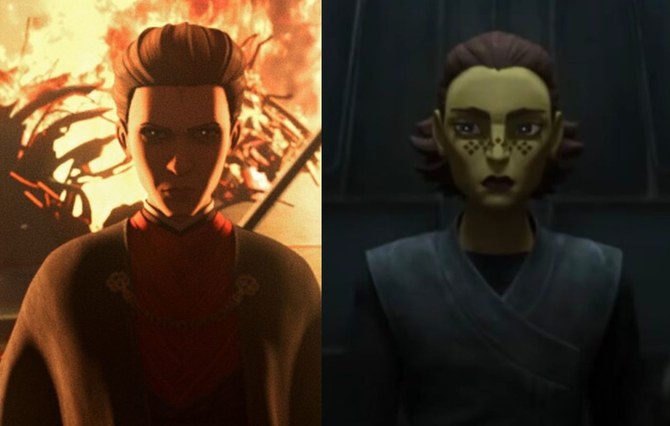
- Focus on characters Morgan Elsbeth and Barriss Offee
- Second anthology of the ‘Star Wars’ animated shorts
DUBAI: The second anthology of the “Star Wars” animated shorts “Star Wars: Tales of the Empire” — following the 2022 collection “Tales of the Jedi” — offers a look behind the curtain at two powerful but under-explored characters from the franchise, Morgan Elsbeth and Barriss Offee.
The first three episodes of the six-parter go back in time to explore how Nightsister Elsbeth was initially drawn to the Empire. Fans of “Star Wars” will be familiar with the character after her live-action appearances in “The Mandalorian” and “Ahsoka.”
Now, with “Tales of the Empire,” Elsbeth makes her animation debut. Diana Lee Inosanto, who plays Elsbeth in both live-action and animation, said she did not feel there was much difference between the two mediums.
In the recording booth, Inosanto — a trained martial artist and godchild to the late Bruce Lee — moved her body to match the action of the scene.
“In my acting approach, I don’t see any difference between being on the set and being in the recording studio, other than the fact that I had to kind of create my own little bubble in being in this space. I still physically do the same preparation and work and the breathing,” said Inosanto in a recent interview with Arab News.
“But yeah, when I first initially read the script for ‘Tales of the Empire,’ I went: ‘Oh my gosh, finally, I understand her,’ because all of those little details were now filled in for me as well. So, I hope the same happens for all the fans. I really think fans are really going to understand now why Morgan was shaped the way she was mentally, why she was wired the way she was, and that she was really coming from a place of being a survivor all her life.”
Meanwhile, the last three episodes of “Tales of the Empire” reveal what becomes of Barriss Offee after Order 66 toward the end of “Star Wars: The Clone Wars” series. A Jedi prodigy, Offee’s character was forever branded a traitor after she turned her back on her kind by bombing the Jedi Temple and framing her friend Ahsoka Tano for it.
Actress Meredith Salenger, who has been waiting for more than a decade to find out what happens to Offee, said to Arab News about her character: “Barriss at the very beginning of ‘Tales of the Empire,’ she is in jail. She has recently been jailed by the Republic. And I think she is particularly conflicted, because she can see what’s happening to the rest of the Jedi. I think she knows when the Jedi Temple explodes and all of these things. She knows it’s gone perhaps too far.”
“And when she’s approached by the Fourth Sister, who is an Inquisitor, it’s sort of like: ‘This is not what I thought my journey would be. I don’t know if I should go along with this. But I also know it’s the only way I’m going to survive.’ There’s a fear that anyone at any time can be killed. I think she’s curious as to what the next step is going to be for her.”
Artist Dalya Moumina: ‘Jeddah is always going to be home to me’
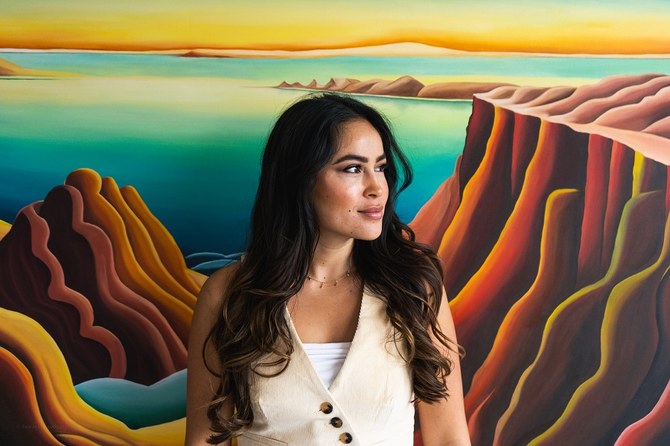
- The NYC-based Saudi-Filipina artist discusses growing up in the Kingdom and how her cultural background has influenced her work
DUBAI: Dalya Moumina is an emerging New York-based artist whose imaginative landscape paintings partially pay tribute to her Arab and Asian heritage. She was born in Washington DC in 1996 to a Saudi-Palestinian father and a Filipina mother. Both were travel lovers, who luckily happened to have met each other on a flight. When Moumina was three years old, her family relocated to Saudi Arabia.
“Jeddah is always going to be home to me. Whenever I go back, it feels like I never left,” Moumina tells Arab News. “Growing up there was very adventurous. I lived the Jeddah lifestyle, right on the Red Sea, which was the best childhood to be honest. I’d go to the beach almost every weekend and we would do desert trips and hiking. I was also a professional horseback rider. I think the part of Jeddah that most influences me is definitely the water. The Red Sea is, in my opinion, the most beautiful sea out there. It’s so blue.”
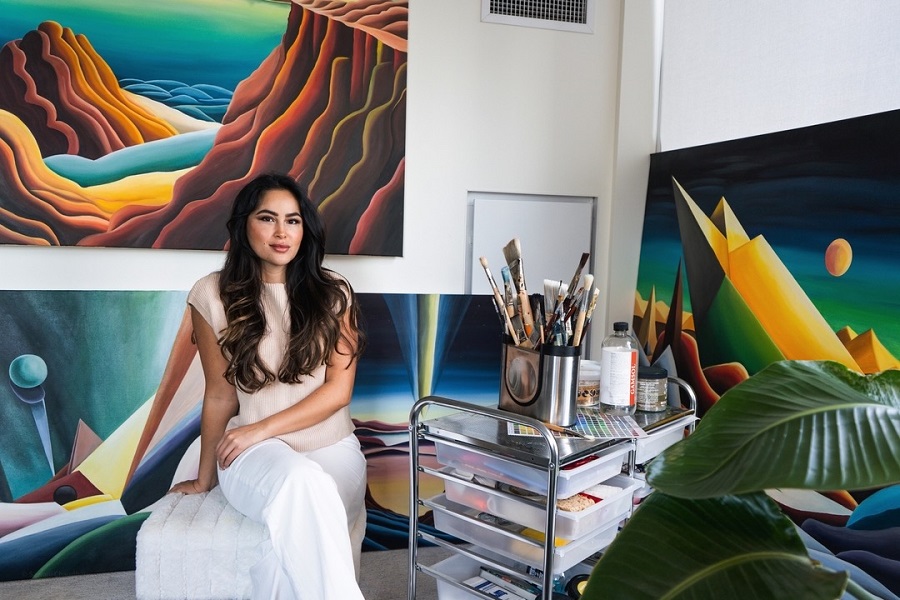
She also has a special connection with the Philippines, which she visited every summer when growing up. “I’d see my mother’s side of the family and my cousins. The people are so kind-hearted. We would go to the islands there, like Boracay and Palawan. They’re absolutely stunning,” she says. “I think I try to bring those influences into my work, especially the tribal communities there. For example, in ceremonies, they’re very into face painting primitive shapes that symbolize different things.”
Those childhood memories have seeped into the bold utopian landscape imagery that Moumina started creating in 2019.
“We have volcanoes and beautiful islands in the Philippines. I think growing up around those extreme and contrasting landscapes led me to amalgamate them into my work, because the meandering, like, rivers and labyrinthine terrains there are unlike any other place, in my opinion — contrasting with the desert landscapes in Saudi Arabia,” she explains.

Although she doesn’t come from an artistic family, Moumina always found herself making collages, scrapbooking and drawing.
“I’ve been painting my whole life. I never took it seriously, but I think it was always an innate part of me,” she says. She also had an aunt who drew and she encouraged her niece. During high school, Moumina took art classes and actually sold her first artwork at a school exhibition.
She later attended the University of Virginia to study business, technology and psychology (along with a few art classes). It was while in Virginia that she discovered the work of American master Georgia O’Keeffe, who famously depicted America’s sweeping mountainous landscapes.
“She used to teach at my university, and she’s such a big inspiration in my work,” says Moumina. “I would say that our styles are similar, but, obviously, I’m trying to distinguish myself.”
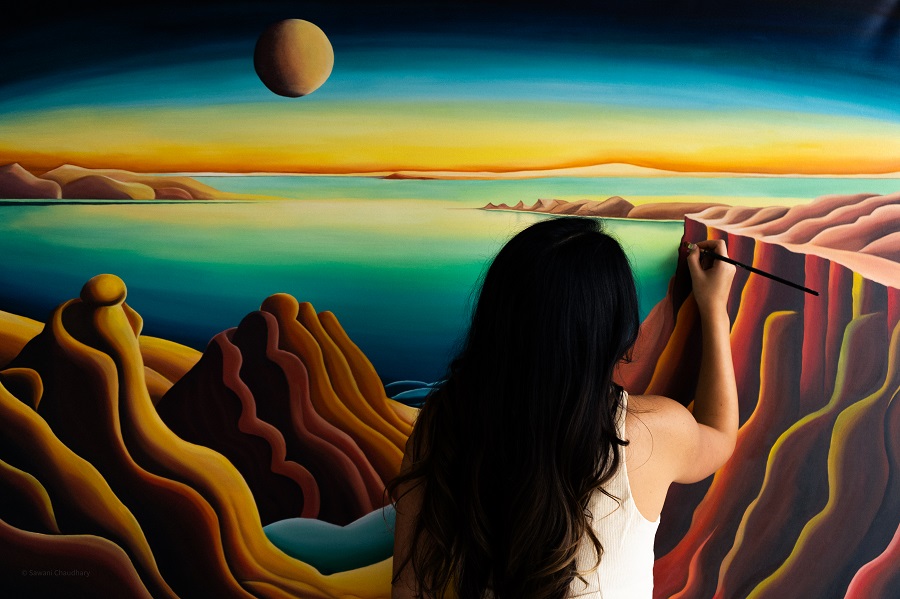
In 2019, Moumina graduated, but a few months later the COVID-19 pandemic hit. She started painting again during lockdowns.
“I really missed traveling, so I was thinking of the landscapes and the ocean from Saudi and the feeling of being by the beach,” she says. “I’ve always loved using oil paint, because it’s slow-drying and the colors are so rich. It’s very therapeutic and relaxing. Sometimes, I’ll play melodic music, other times I’ll work in silence. Whenever I start painting, I just go into a flow state of mind and work for hours — forgetting to eat. You don’t even realize it.”
Moumina’s arresting landscapes feel otherworldly, isolated and fantasy-like. At times, a large yellow sun dominates the composition, above wave-like mountains and flowing rivers. Inspired by cubism and surrealism, Moumina executes her paintings in three-dimensions, with sharp contrasts and bold colors.
“Each piece, I’d say, has a distinctive energy and character,” she says. “I don’t want people to just look at the work, I want them to feel something and walk away thinking about it more, and thinking something new. I try to lure people in through the energizing presence of fresh possibilities. . . I hope people see, through my work, that everything is simply interconnected and interactive.”

Along with the vivid colors and energy in Moumina’s work, there is also a sense of somberness. “There’s so much happening in the world,” she says. “I think of my grandmother, who was Palestinian. She was evicted from her home back in the Forties, and I made a painting that was inspired by her. Because I live all the way in New York, it’s kind of hard to keep in touch with what’s happening in the Middle East.”
Moumina has been living in New York — which she describes as “the art capital of the world” — for two years, and she is represented by GR Gallery. On May 3, a group show, “Transfiguration,” opened at the gallery. The show includes a selection of Moumina’s nature pieces. She says that being an artist in a well-established art scene like New York is competitive, and that she has considered doing a Master’s degree in art, but she realized that she needed something more in order to succeed.
“What helps you in this industry is networking and not staying in your studio 24/7,” says Moumina, who describes herself as sociable and extroverted. “Half of it is also connecting with other artists and really putting yourself out there.”
She also believes that being both Saudi and a woman has been an advantage so far in her career. “I think it’s still a male-dominated field,” she says. “But a lot of gallery owners are trying to bring up more female artists, because that’s what’s kind of in demand nowadays.”




